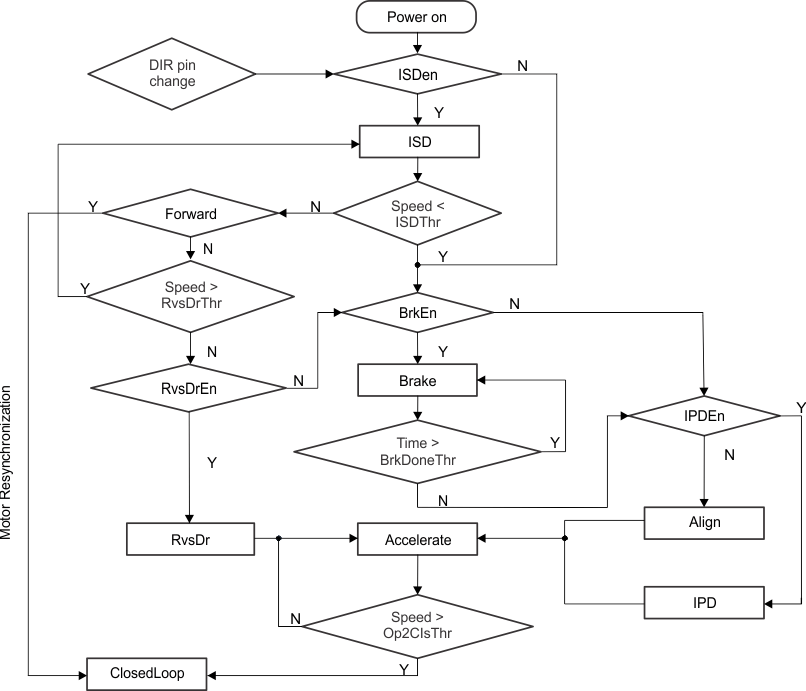ZHCSDA7G July 2014 – February 2018 DRV10983
PRODUCTION DATA.
- 1 特性
- 2 应用
- 3 说明
- 4 修订历史记录
- 5 说明 (续)
- 6 Pin Configuration and Functions
- 7 Specifications
-
8 Detailed Description
- 8.1 Overview
- 8.2 Functional Block Diagram
- 8.3 Feature Description
- 8.4
Device Functional Modes
- 8.4.1 Motor Parameters
- 8.4.2 Starting the Motor Under Different Initial Conditions
- 8.4.3 Motor Start Sequence
- 8.4.4 Start-Up Current Setting
- 8.4.5 Closed Loop
- 8.4.6 Current Limit
- 8.4.7 Lock Detect and Fault Handling
- 8.4.8 AVS Function
- 8.4.9 PWM Output
- 8.4.10 FG Customized Configuration
- 8.4.11
Diagnostics and Visibility
- 8.4.11.1 Motor Status Readback
- 8.4.11.2 Motor Speed Readback
- 8.4.11.3 Motor Electrical Period Readback
- 8.4.11.4 BEMF Constant Readback
- 8.4.11.5 Motor Estimated Position by IPD
- 8.4.11.6 Supply Voltage Readback
- 8.4.11.7 Speed Command Readback
- 8.4.11.8 Speed Command Buffer Readback
- 8.4.11.9 Fault Diagnostics
- 8.5 Register Maps
- 9 Application and Implementation
- 10Power Supply Recommendations
- 11Layout
- 12器件和文档支持
- 13机械、封装和可订购信息
8.4.3 Motor Start Sequence
Figure 12 shows the motor start sequence implemented in the DRV10983.
 Figure 12. Motor Starting-Up Flow
Figure 12. Motor Starting-Up Flow
- Power-On StateThis is the initial power-on state of the motor start sequencer (MSS). The MSS starts in this state on initial power-up or whenever the DRV10983 comes out of either standby or sleep modes.
- ISDen JudgmentAfter power on, the DRV10983 MSS enters the ISDen Judgment where it checks to see if the Initial Speed Detect (ISD) function is enabled (ISDen = 1). If ISD is disabled, the MSS proceeds directly to the BrkEn Judgment. If ISD is enabled, the motor start sequence advances to the ISD state.
- ISD StateThe MSS determines the initial condition of the motor (see ISD).
- Speed<ISDThr JudgmentIf the motor speed is lower than the threshold defined by ISDThr[1:0], then the motor is considered to be stationary and the MSS proceeds to the BrkEn judgment. If the speed is greater than the threshold defined by ISDThr[1:0], the start sequence proceeds to the Forward judgment.
- Forward Judgment The MSS determines whether the motor is spinning in the forward or the reverse direction. If the motor is spinning in the forward direction, the DRV10983 executes the resynchronization (see Motor Resynchronization) process by transitioning directly into the ClosedLoop state. If the motor is spinning in the reverse direction, the MSS proceeds to the Speed>RvsDrThr.
- Speed>RvsDrThr JudgmentThe motor start sequencer checks to see if the reverse speed is greater than the threshold defined by RvsDrThr[2:0]. If it is, then the MSS returns to the ISD state to allow the motor to decelerate. This prevents the DRV10983 from attempting to reverse drive or brake a motor that is spinning too quickly. If the reverse speed of the motor is less than the threshold defined by RvsDrThr[2:0], then the MSS advances to the RvsDrEn judgment.
- RvsDrEn JudgmentThe MSS checks to see if the reverse drive function is enabled (RvsDrEn = 1). If it is, the MSS transitions into the RvsDr state. If the reverse drive function is not enabled, the MSS advances to the BrkEn judgment.
- RvsDr StateThe DRV10983 drives the motor in the forward direction to force it to rapidly decelerate (see Reverse Drive). When it reaches zero velocity, the MSS transitions to the Accelerate state.
- BrkEn JudgmentThe MSS checks to determine whether the brake function is enabled (BrkDoneThr[2:0] ≠ 000). If the brake function is enabled, the MSS advances to the Brake state.
- Brake StateThe device performs the brake function (see Motor Brake).
- Time>BrkDoneThr JudgmentThe MSS applies brake for time configured by BRKDontThr[2:0]. After brake state, the MSS advances to the IPDEn judgment.
- IPDEn JudgmentThe MSS checks to see if IPD has been enabled (IPDCurrThr[3:0] ≠ 0000). If the IPD is enabled, the MSS transitions to the IPD state. Otherwise, it transitions to the align state.
- Align StateThe DRV10983 performs align function (see Align). After the align completes, the MSS transitions to the Accelerate state.
- IPD StateThe DRV10983 performs the IPD function. The IPD function is described in Initial Position Detect (IPD). After the IPD completes, the MSS transitions to the Accelerate state.
- Accelerate StateThe DRV10983 accelerates the motor according to the setting StAccel and StAccel2. After applying the accelerate settings, the MSS advances to the Speed > Op2ClsThr judgment.
- Speed>Op2ClsThr JudgmentThe motor accelerates until the drive rate exceeds the threshold configured by the Op2ClsThr[4:0] settings. When this threshold is reached, the DRV10983 enters into the ClosedLoop state.
- ClosedLoop StateIn this state, the DRV10983 drives the motor based on feedback from the commutation control algorithm.
- DIR Pin Change JudgmentIf DIR pin get changed during any of above states, DRV10983 stops driving the motor and restarts from the beginning.